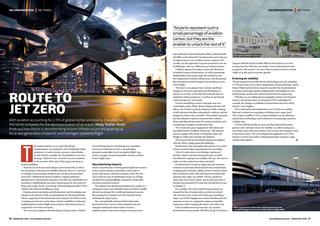




DECARBONISATION | AIR TRAVEL ROUTE TO JET ZERO With aviation accounting for 2.5% of global carbon emissions, it is vital that the sector prepares for the decarbonisation of air travel. Molly Tooher-Rudd finds out how Atkins is decarbonising airport infrastructure and gearing up for a new generation of electric and hydrogen-powered flight T he aviation industry is on a path of profound transformation. Accounting for 2.5% of all global carbon emissions, it is under intense pressure to decarbonise. In July 2022 for example, the UK published its Jet Zero Strategy, which sets out a vision for net zero emissions in the sector by 2050, and a 2040 target aimed just at aviation buildings. With the rise of electric and hydrogen-powered aircraft, as well as the emergence of advanced air mobility solutions, there is a vital need to redesign existing airspace infrastructure for this new generation of aircraft. Collaborations between airlines, original equipment manufacturers, infrastructure operators, and other key stakeholders are essential to establishing the necessary infrastructure for new forms of flying, such as the electric vertical take-off and landing aircraft(eVTOL) vehicles that will soon be filling our skies. Existing airport operations and infrastructure need to undergo vast changes to decarbonise while accommodating new flying technology. Atkins is applying its Decarbonomics tool to airports, in a bid to create a roadmap towards net zero for them, and has established a dedicated multidisciplinary Future Flight team to look at what infrastructure is required for new forms of aviation. Were actively engaged in decarbonising existing aviation, whether 30 September 2023 www.cibsejournal.com its retrofitting airports, introducing new propulsion systems to traditional aircraft, or spearheading genuinely sustainable electric propulsion flight, says Andrew Caughey, head of sustainable aviation at Atkins Future Flight team. Decarbonising airports Atkins Decarbonomics tool has gained significant traction in the aviation industry, particularly in the realm of airport operations. Launched in January 2022, the tool was created as a way of tackling the energy use of large portfolios of existing buildings, using data to help make decisions around investment. The initiative has demonstrated impressive results; it is estimated to have saved 300,000 tonnes of carbon. Initially devised as a strategy for retrofitting housing, its success has prompted an expansion into the industrial sector, including the airport space. The concept builds a framework for clients that benchmarks their current carbon footprints, devises strategic roadmaps for intervention, oversees implementation, and ensures long-term measurement